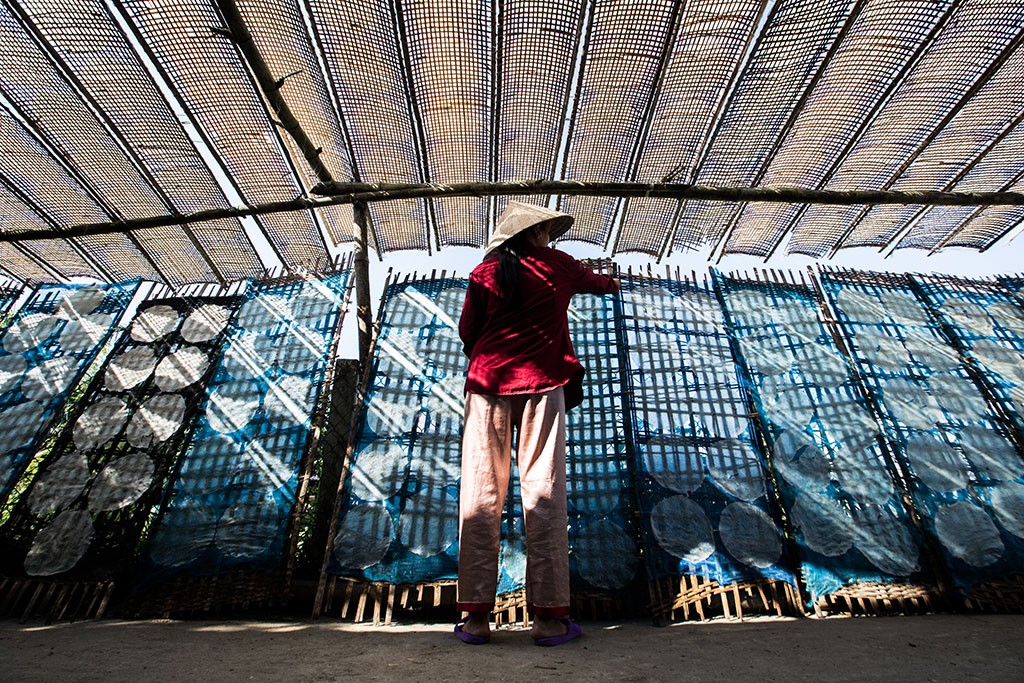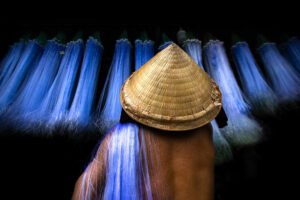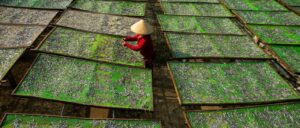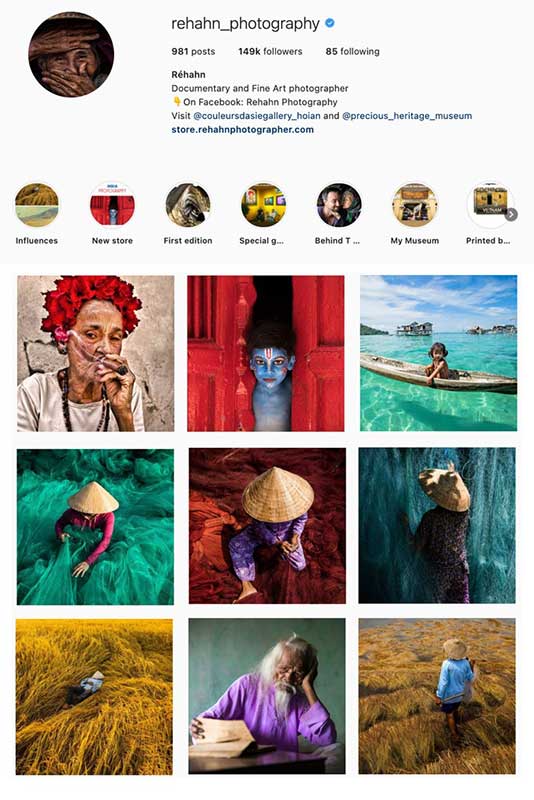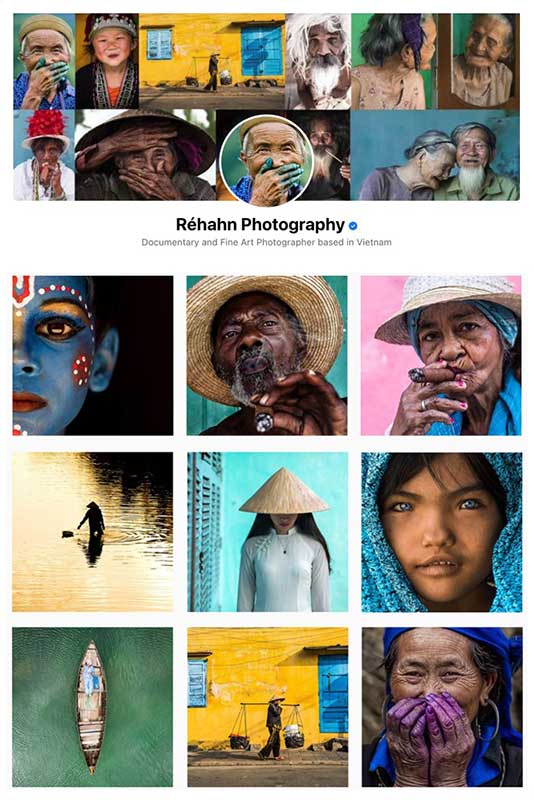In the weeks preceding Tet, an explosion of colors and scents hit Vietnam.
If you love taking photographs, this is the perfect time to go out for a few unforgettable photo excursions before everything closes down for the holidays.
Hoi An, where I live, is a treasure trove of traditional crafts, artisanal skills, and fashion all year round. However, there are certain jobs, such as incense crafting, heritage agriculture and cultural gastronomy that heighten in intensity leading up to the holiday.
Read on to discover some of Hoi An’s most spectacular offerings for Vietnam’s famous Tet Lunar New Year.
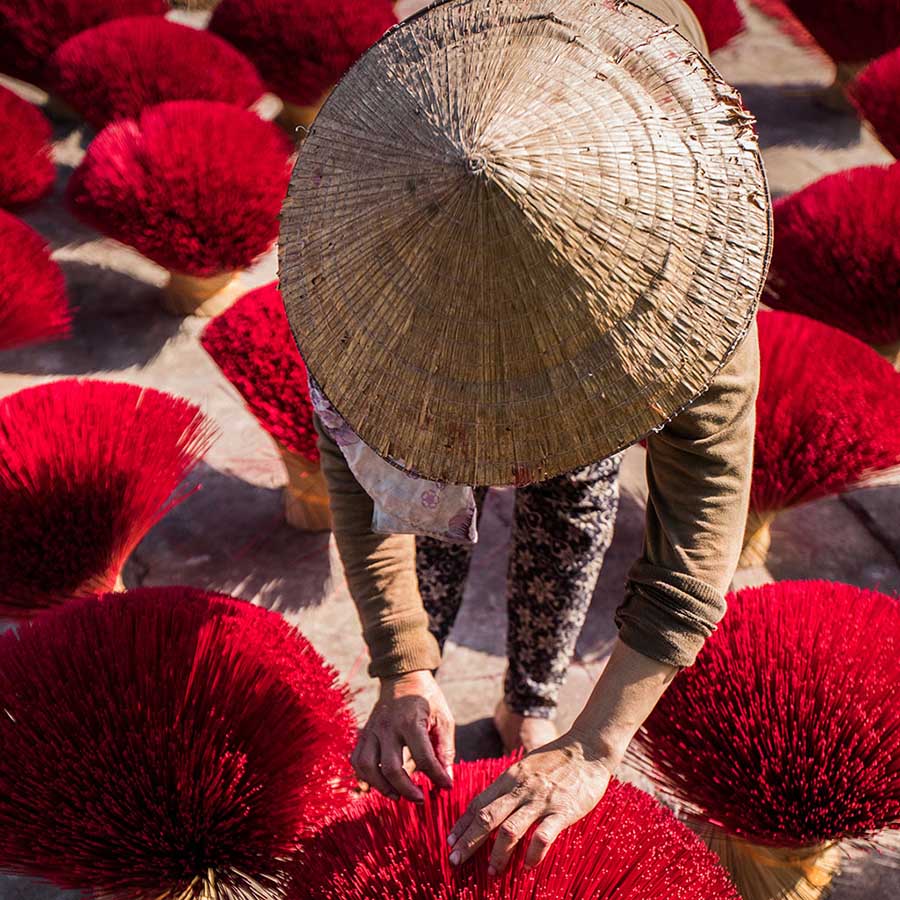
Tet in Hoi An
The Lunar New Year is the most important yearly event across Vietnam and much of Asia. It celebrates the arrival of spring as well as being an occasion to pay respects to one’s ancestors.
The importance of the holiday can be found in its full name. Tet Nguyen Dan, “Tet” for short, literally means “Feast for the First Morning of the First Day” in Sino-Vietnamese.
Commerce and enterprises shut down for a week and hardworking employees are free to travel to their hometowns for feasts, family festivities and essential traditions. Employers typically give a yearly bonus for Tet, allowing workers to have a bit more spending power for holiday gifts and food.
One can see farms and florists stocked with pine trees a month or two before the Christmas holidays in the West. In contrast, the streets before Tet become botanical gardens overflowing with kumquats, apricot trees and fragrant peach blossoms.
Incense crafting is another celebrated skill for Tet. The sticks are rolled in fragrant colors and laid out to dry by traditional artisans. They create a mosaic of jewel tones that makes for a stunning sight.
And of course, no holiday would be complete without its cultural foods. It’s common to see Hoi An locals selling their special green bean cakes leading up to the holidays.
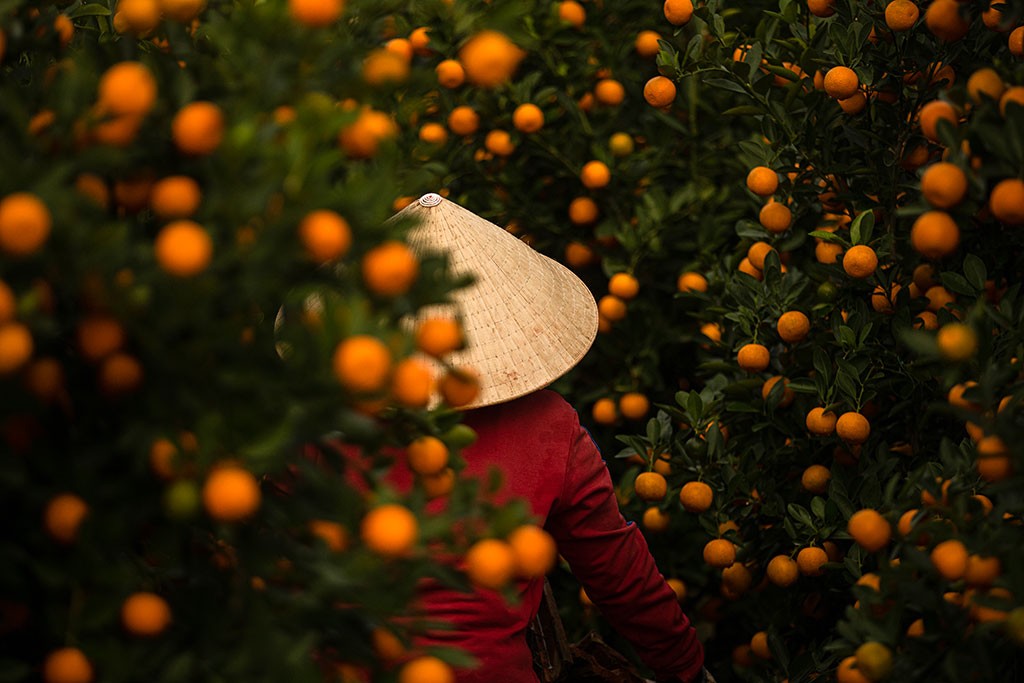
Golden Coins and Kumquats
In Vietnam, trees have special importance for Tet. It took me some time to understand the subtle differences between regional traditions. Peach blossoms are seen more often in the North, while apricot blossoms are preferred in Southern Vietnam.
Peach blossoms are deep pink, like the tutus of 1000s of tiny ballerinas. Apricot blossoms in the south are a cheerful yellow. Both trees are stunning and fragrant. They are undoubtedly the perfect symbols for lifting anyone’s holiday spirits.
In Hoi An, where I live, the kumquat tree reigns supreme. I love the weeks leading up to Tet, when these little trees can be seen everywhere. Their deep green leaves are highlighted by perfect orange globes.
I’m always impressed by the supernatural strength of the trees’ branches. The kumquats are so abundant that they seem ready to drop at any minute. Yet, they hang there as if showing off, brilliant and rich as golden coins. It’s no wonder that the trees are symbols for fertility and success!
The kumquats represent the grandparents and ancestors. The flowers symbolize the parents and the young leaves are the grandchildren. They are living, breathing family trees.
In Vietnamese culture, people believe that the more fruit that is present on the Kumquat tree the more luck it will bring.
The competition between cultivators of these trees is strong. Each potted tree must be perfectly pruned to showcase the fruit for maximum beauty. It’s a matter of pride to have the best trees to offer for the New Year.
I was lucky to capture a few photographs of a woman tending to her kumquat trees. She was in the process of verifying the pots and making sure that they were clean of stray leaves, fallen fruit and insects.
These photos make me think of an otherworldly galaxy. As if this woman is afloat in a constellation of miniature glowing suns.
I love the fact that on the first day of Tet, these trees will shine in the homes of people through-out Hoi An, bringing light and joy to all who regard them.
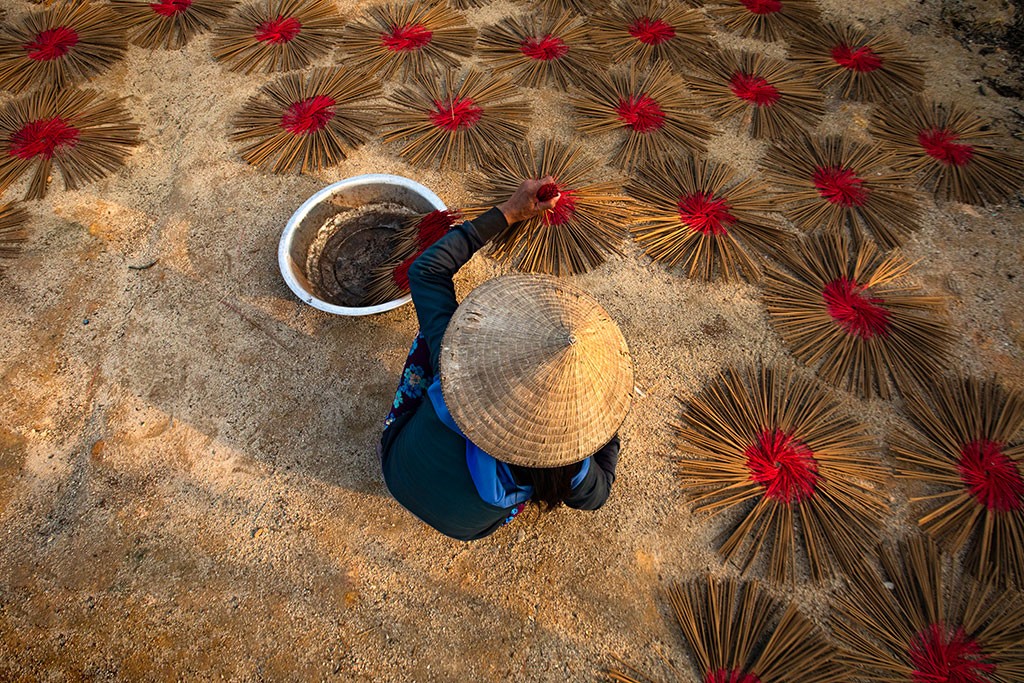
The Importance of Incense
Incense is essential in Vietnamese culture all year round. However, during the Tet holidays, it takes on a special role.
The festival is based around family, heritage and ancestors. Lighting incense for those who have already departed is an important ritual. The smoke from the incense can also lift the New Year prayers of the family up into the spiritual realm.
Vietnam is one of the largest fabricators of incense in the world, just after China. Yet, despite what might seem like mass production, the crafting methods have largely stayed the same for centuries.
Incense production is a living piece of crafting history!
In the months leading up to Tet, I often come across artisans preparing the fragrant sticks. The phenomenal colors of the incense gathered by the thousands into fan-like bundles is a sight that can truly take visitors into a different realm.
Many incense businesses are family-run. Generations of the same family gather to prepare the sticks (often entirely by hand) to keep up with the increased holiday demand.
It’s hard work to sand down the bamboo sticks, dip them in colorful dye and a paste made from wood powder, resin, and spicy barks such as cinnamon or sandalwood. Yet, the importance of each combustible stick keeps the work of these artisans alive and essential.
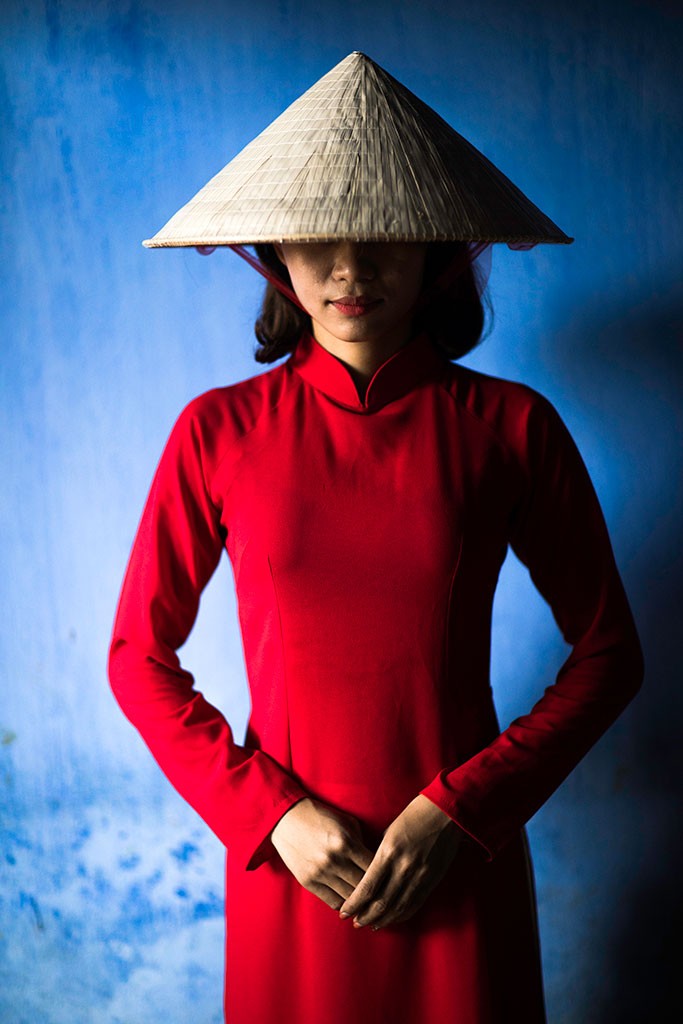
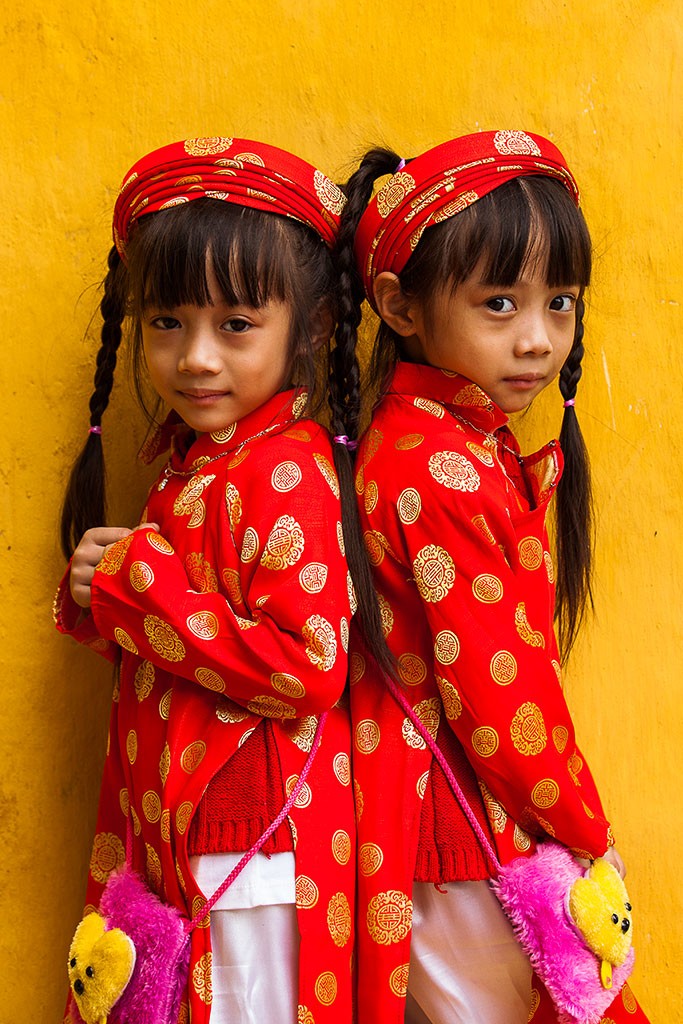
The Season for Ao Dai
Part of Hoi An’s charm comes from the fact that so much cultural heritage remains present in the town. From architecture to artisanal agriculture, there are countless things that remind the viewer of Hoi An’s storied history, as well as its bright future.
I’ve taken hundreds of photographs of Hoi An locals in their beautiful traditional Ao Dai garments. From students in their pure white Ao Dai uniforms to the luxurious, embroidered ensembles that are worn on special occasions, the traditional dress is still a large part of Vietnamese culture. However, more and more it is slowly being replaced by t-shirts and jeans. The exception is during the Tet holidays. Everyone from men to women to children don their finest traditional garb.
Red and yellow are popular colors during the Lunar New Year festivities because they are said to bring luck and happiness. Red is often seen on brides throughout the year for the same reasons.
Ao Dai can be purchased ready-made. But in Hoi An, which is famous for its talented tailors, it is possible to have any type of Ao Dai made to your exact measurements.
I find these garments to have a poetic beauty that seems utterly modern and elegant while also representing Vietnamese heritage and patriotism.
Read the article about the traditional dress, Ao Dai in Vietnam
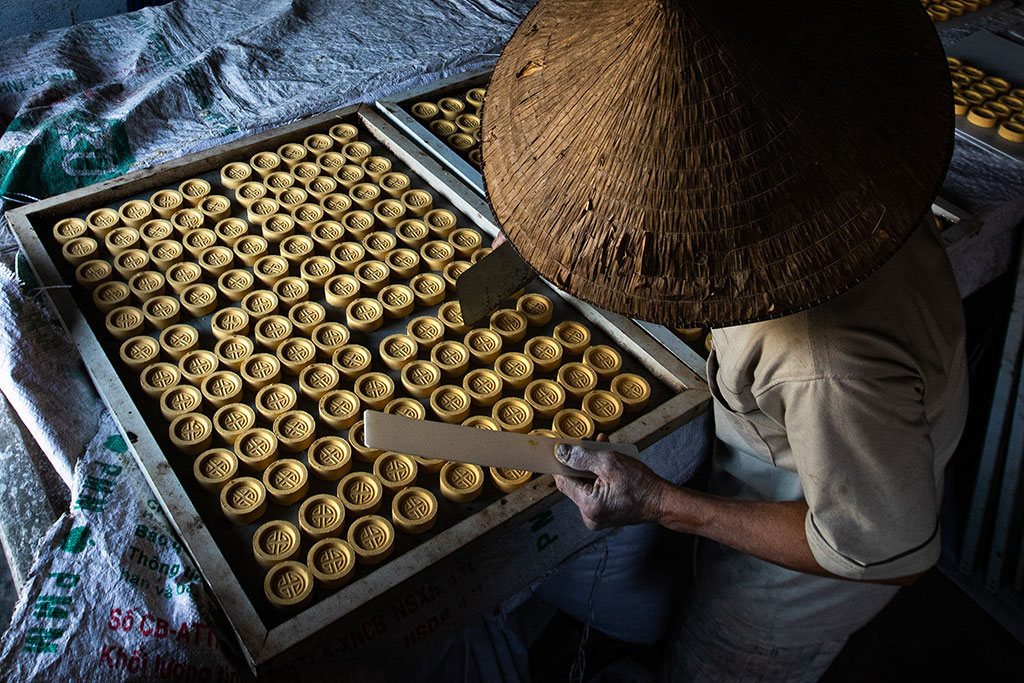
Green Bean Cakes and Rice Paper
No holiday would be complete without a feast!
Tet has plenty of traditional foods that are famous throughout the country. Banh Chung, a meat-filled sticky rice cake wrapped in banana leaves, is one of the most popular meals. But all sorts of sweets and savories make their way into the week-long festivities.
Banh Dau Xanh, or green bean cakes, are one of my favorite Tet treats. They are little cubes composed of green bean powder, sugar, and sticky rice. The cakes are delicately sweet and buttery. They make perfect gifts or afternoon snacks with a cup of green tea.
Banh dau xanh are available year round in Hoi An but they are especially beautiful around the Tet holiday. The soft sweets are pressed with symbolic designs and look like little wrapped packages.
Traditionally the cakes were made using wooden cake molds, but, like most objects nowadays, they’ve been streamlined into plastic.
Green bean cakes were originally created as gifts for the Emperor Bao Dai. Beyond being delicious, the cakes also represent the end of an era. Bao Dai was the 13th and final Emperor of Vietnam’s Nguyen dynasty.
The cakes are still enjoyed today as part of the rich culinary history of the country.
Another food product that is fabricated all around Hoi An are the eponymous rice paper wraps. Banh Trang as they’re called in Vietnamese are enjoyed year round. However, the process picks up speed just before Tet.
Banh Trang are used in dozens of traditional Vietnemese dishes such as fresh spring rolls, fried nem, salads and more. With all the feasts and family festivities during the holiday week, they are in high demand.
Banh Trang are made from steamed rice batter and/or tapioca starch, then pressed into paper thin discs. Traditionally, the discs are then dried in the sun. You can see this ancient method all around Hoi An. Rice paper produced for export is typically steamed and dried in a machine.
